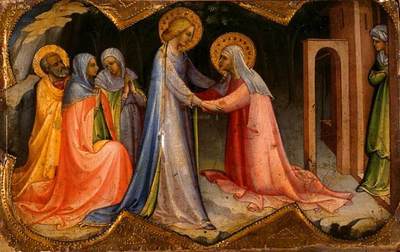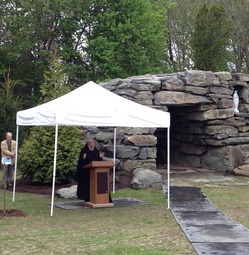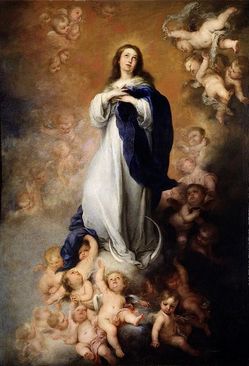Category: Blessed Virgin Mary
The Visitation of Mary to Elizabeth
The Word of God is not a literary expression, but is the indication of an event, it is always a fact: the Word of God is Christ. His word starts from the promise of an event. The figure of the Virgin is completely filled with memory, the word of her people, stretching completely toward the meaning of these events (the Angel’s announcement, Elizabeth’s greeting). This is why Elizabeth used the highest form of address: ‘Blessed is she who believed in the fulfillment of the Word of the Lord.’
Monsignor Luigi Giussani
Portsmouth Abbey monks dedicate Lourdes Grotto
Continue reading Portsmouth Abbey monks dedicate Lourdes Grotto
The Golden Rose given to Our Lady of Charity of Cobre, Cuba
 A rose among thorns. Well, almost. Man and woman
A rose among thorns. Well, almost. Man and woman
always want to give an expression of love and affection to another. In the
course of history you will notice the gifts of love’s sentiment and reality
given to God, the Blessed Virgin Mary and the saints. Visit a shrine where
healings are reported and you’ll notice tokens of gratitude: lockets, flowers, chalices, artwork, and the like. One beautiful gift of
love was given by Pope Benedict Monday evening to the Virgen de la Caridad de
Cobre in Cuba: a golden rose. The papal gift of a golden rose dates back to the
middle ages when a pope held a golden rose in a procession on Laetare Sunday,
the fourth Sunday of Lent. It was Pope Eugene III who called the rose a sign of
Christ’s passion: the gold symbolizing the resurrection and the thorns the
suffering.
expanding the meaning: a personal honor and a reminder: do not forget the
responsibilities and duties that come with being a Christian. Beyond the human
honor given to royalty, the rose was given to abbeys and sanctuaries of the
Virgin Mary. Pope John Paul II gave a few these roses to shrines and Pope
Benedict XVI is fond of the custom and so he’s given roses to Altötting, Mariazell,
Fatima, Aparecida, USA and now to Cuba.
The Annunciation of the Lord
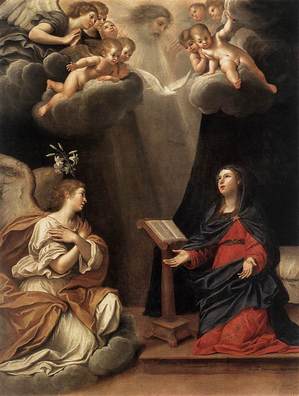 The mystery of the annunciation to Mary is not just a
The mystery of the annunciation to Mary is not just a
mystery of silence. It is above and beyond all that a mystery of grace.
feel compelled to ask ourselves: Why did Christ really want to be born of a
virgin? It was certainly possible for him to have been born of a normal
marriage. That would not have affected his divine Sonship, which was not
dependent on his virgin birth and could equally well have been combined with
another kind of birth. There is no question here of a downgrading of marriage
or of the marriage relationship; nor is it a question of better safeguarding
the divine Sonship. Why then?
and see that the mystery of Mary is prepared for at every important stage in
salvation history. It begins with Sarah, the mother of Isaac, who had been
barren, but when she was well on in years and had lost the power of giving life,
became, by the power of God, the mother of Isaac and so of the chosen people.
process continues with Anna, the mother of Samuel, who was likewise barren, but
eventually gave birth; with the mother of Samson, or again with Elizabeth, the
mother of John the Baptizer. The meaning of all these events is the same: that
salvation comes, not from human beings and their powers, but solely from
God–from an act of his grace.
for Every Day of the Year (1992), 99-100.
Annunciation of the Lord
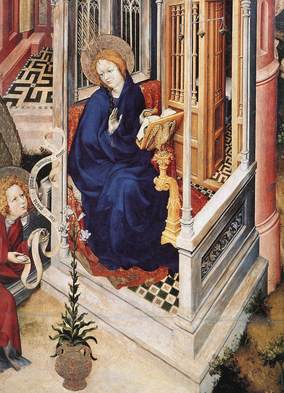 Mary would never see the world in the same way again because she had conceived beneath her heart, The Word, the Son of God made flesh within her. The Word from the mind of God now in her being…She would now have to see everything through the eyes of that Word and everything would change. “Nothing would again be causal and small, but everything with light invested,” (J. Duffy, “The Annunciation”). Christ, the Light of the World.
Mary would never see the world in the same way again because she had conceived beneath her heart, The Word, the Son of God made flesh within her. The Word from the mind of God now in her being…She would now have to see everything through the eyes of that Word and everything would change. “Nothing would again be causal and small, but everything with light invested,” (J. Duffy, “The Annunciation”). Christ, the Light of the World.
The Visitation as a model for Christian life
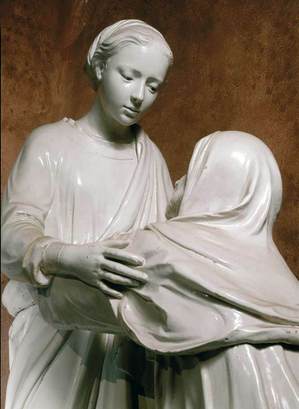 Advent is moving us closer and closer to the Incarnation of the Eternal Word of God–Jesus. Among the rich readings of sacred Scripture we have in the Liturgy, there is today’s that recalls for us Mary’s visiting her cousin Elizabeth who is pregnant with John the Baptist. The Visitation is the second of the Joyful Mysteries of the Holy Rosary.
Advent is moving us closer and closer to the Incarnation of the Eternal Word of God–Jesus. Among the rich readings of sacred Scripture we have in the Liturgy, there is today’s that recalls for us Mary’s visiting her cousin Elizabeth who is pregnant with John the Baptist. The Visitation is the second of the Joyful Mysteries of the Holy Rosary.
Our Lady of Guadalupe, Partroness of America
Why is the Immaculate Conception important?
What did we hear today from the sacred Liturgy about the Immaculate Conception of the Blessed Virgin Mary? How close to did you pay attention to the priest praying the Mass prayers on your behalf? What’s the import of the feast? To know the answers we have to look at the texts of today’s Liturgy. Did you notice when the priest prayed:
1. God preserved Mary from every stain of sin by foreseeing the death of His Son Jesus, and so we pray too, that is, we hope to be cleansed of sin and admitted to communion with Him;
2. we profess belief in God’s prevenient grace given to Mary and we hope that He will deliver us from sin;
3. in the Preface, the priest prays that in Mary who was “endowed with the rich fullness of your [God’s] grace … [there is] a worthy Mother for your Son and [which] signify the beginning of the Church; As Pope Benedict said today, “Mary, on the other hand,” he continued, “is Immaculate, free from all stain of sin. The Church is holy, but at the same time marked by our sins.”
4. in her yes to God’s invitation to be the Mother of Jesus, we have the “Lamb would wipe away our offenses”;
5. we pray that the singular grace given to Mary may also be given to us.
This Liturgy is a mix of liturgical, dogmatic and systematic theology. BTW, this is fitting way to celebrate the graces given to our nation.
Immaculate Conception of the Blessed Virgin Mary
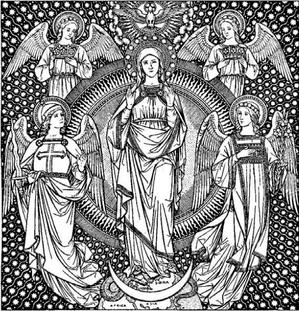 The dogma of Mary’s Immaculate Conception was given to us by Pope Pius IX and proclaimed in the document, Ineffabilis Deus (1854), solemnly defining a clear and consistent teaching of the Church since 33 AD.
The dogma of Mary’s Immaculate Conception was given to us by Pope Pius IX and proclaimed in the document, Ineffabilis Deus (1854), solemnly defining a clear and consistent teaching of the Church since 33 AD.
If you ask the question: What can you tell me about Mary as Patroness of America? Boston’s Archbishop (later Cardinal) Richard Cushing wrote an answer.
Famously, the 23 US bishops in 1846 (note: nearly a decade before the dogma’s definition) wrote to the Pope asking for Mary under the title of the Immaculate Conception to be bestowed on the country’s young Church. The bishops wrote:
We take this occasion, brethren, to communicate to you the determination, unanimously adopted by us, to place ourselves and all entrusted to our charge throughout the United States, under the special patronage of the holy Mother of God, whose Immaculate Conception is venerated by the piety of the faithful throughout the Catholic Church.
By the aid of her prayers, we entertain the confident hope that we will be strengthened to perform the arduous duties of our ministry, and that you will be enabled to practice the sublime virtues, of which her life presents the most perfect example.
Pastoral Letter of the Bishops of the United States
Sixth Provincial Council, Baltimore, 5 May 1846

